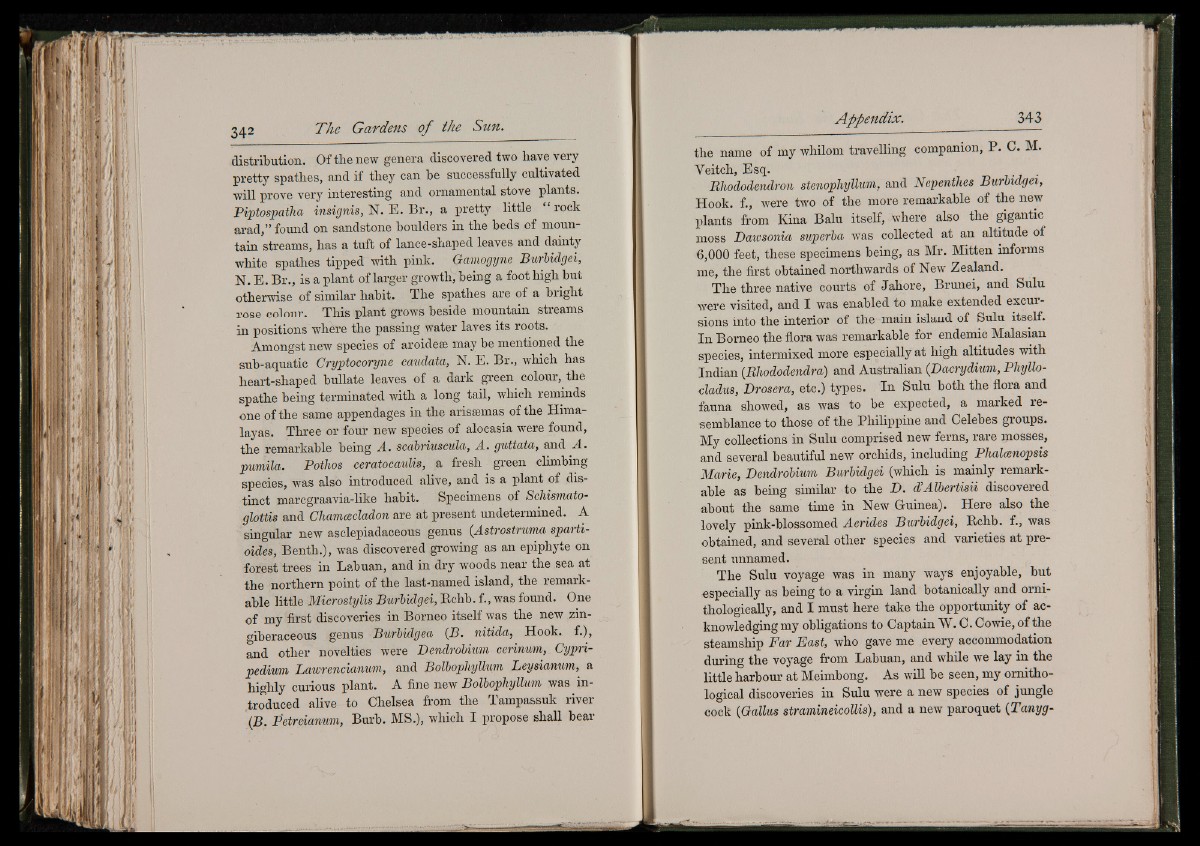
distribution. Of the new genera discovered two have very
pretty spathes, and if they can he successfully cultivated
will prove very interesting and ornamental stove plants.
Piptospatha insignis, N. E. Br., a pretty little “ rock
arad,” found on sandstone boulders in the beds of mountain
streams, has a tuft of lance-shaped leaves and dainty
white spathes tipped with pink. Gamogyne Burbidgei,
N. E. Br., is a plant of larger growth, being a foot high but
otherwise of similar habit. The spathes are of a bright
rose colour. This plant grows beside mountain streams
in positions where the passing water laves its roots.
Amongst new species of aroidete may be mentioned the
sub-aquatic Cryptocoryne caudata, N. E. Br., which has
heart-shaped bullate leaves of a dark green colour, the
spathe being terminated with a long tail, which reminds
one of the same appendages in the arisaemas of the Himalayas.
Three or four new species of alocasia were found,
the remarkable being A. seabriuscula, A. guttata, and A.
pumila. Pothos ceratocaulis, a fresh green climbing
species, was also introduced alive, and is a plant of distinct
marcgraavia-like habit. Specimens of Schismato-
gbttis and Chamcecladon are at present undetermined. A
singular new asclepiadaceous genus (Astrostruma sparti-
oides, Benth.), was discovered growing as an epiphyte on
forest trees in Labuan, and in dry woods near the sea at
the northern point of the last-named island, the remarkable
little Microstylis Burbidgei, Bchb. f., was found. One
of my first discoveries in Borneo itself was the new zin-
giberaceous genus Burbidgea (-B. nitida, Hook, f.),
and other novelties were Dendrobium cerinum, Cypri-
pedAum Lawrencianum, and Bolbophyllmn Leysianum, a
highly curious plant. A fine new Bolbopliyllum was introduced
alive to Chelsea from the T ampassuk river
(2J. Petreianum, Burb. MS.), which I propose shall bear
the name of my whilom travelling companion, P. C. M.
Yeitch, Esq.
Rhododendron stenopliyllum. and Nepenthes Burbidgei,
Hook, f., were two of the more remarkable of the new
plants from Kina Balu itself, where also the gigantic
moss Dawsonia superba was collected at an altitude of
6,000 feet, these specimens being, as Mr. Mitten informs
me, the first obtained northwards of New Zealand.
The three native courts of Jahore, Brunei, and Sulu
were visited, and I was enabled to make extended excursions
into the interior of the main island of Sulu itself.
In Borneo the flora was remarkable for endemic Malasian
species, intermixed more especially at high altitudes with
Indian (Rhododendra) and Australian (Dacrydium, Phylb-
cladus, Drosera, etc.) types. In Sulu both the flora and
fauna showed, as was to be expected, a marked resemblance
to those of the Philippine and Celebes groups.
My collections in Sulu comprised new ferns, rare mosses,
and several beautiful new orchids, including Plialanopsis
Marie, Dendrobium Burbidgei (which is mainly remarkable
as being similar to the D. d’Albertisii discovered
about the same time in New Guinea). Here also the
lovely pink-blossomed Aerides Burbidgei, Bchb. f., was
obtained, and several other species and varieties at present
unnamed.
The Sulu voyage was in many ways enjoyable, but
especially as being to a virgin land botanically and orni-
thologically, and I must here take the opportunity of acknowledging
my obligations to Captain W. C. Cowie, of the
steamship Far East, who gave me every accommodation
during the voyage from Labuan, and while we lay in the
little harbour at Meimbong. As will be seen, my ornithological
discoveries in Sulu were a new species of jungle
cock (Gallus stramineicollis), and a new paroquet (Tanyg